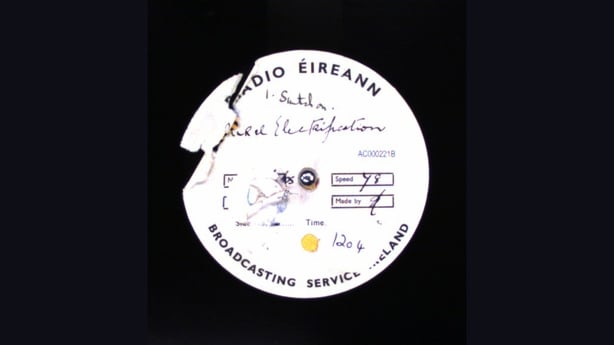The impact electric power will have on the Tipperary village of Bansha.
Three recordings from a feature illustrating one parish's journey to electrification in the late 1940s, reflects some of the conversations happening around the country at the time.
In November 1946 the Electricity Supply Board (ESB) embarked on a scheme to bring electricity to rural and remote areas of Ireland, known as the Rural Electrification Scheme.
The original scheme, which ended in 1964, was referred to as the quiet revolution owing to the significant socio-economic changes it brought about, affecting the working and social lives of people all over the country.
The first electricity pole was erected on 5 November 1946 at Kilsallaghan in north county Dublin, with the first lights switched on at Oldtown, north Dublin, in January 1947.
According to the ESB Archives, by 1965, the scheme had connected almost 300,000 houses to the supply system at a total cost of £36 million.
The Rural Electrification Office of the ESB worked with Radio Éireann to produce a radio programme titled 'The Electrification of Bansha' using a case study of Bansha, County Tipperary. This was a descriptive feature illustrating how electricity came to the parish and the benefits it brought to the community, industry, health care, farming and homemaking.

The programme used dramatic reconstructions of many incidents which occurred during the process of electrification, including initial meetings, ESB canvassing and descriptions of the many benefits electric power would bring to the parish.
The journey to electrification in the parish was not without difficulty. According to an article in the Sligo Champion from 22 January 1949, "It meant meetings, discussion and the sinking of differences, and it meant a new outlook for a village which was moribund".
Father J.M. Hayes was a leading figure working to convince the community to adopt to electricity. A report from the Nationalist, 26 July 1947, told how,
"That it would cause a revolution in the countryside, that every house and farmstead in the parish from the Galtees to the Suir would have electric light and power, was stated by Very Rev. J.M. Hayes, P.P. at a largely attended and enthusiastic public meeting in the Parochial Hall, Bansha, when he announced that the scheme initiated by the Parish Council of Muintir na Tire for the electrification of Bansha area had been sanctioned by the ESB."
According to the ESB Archives, "Once an area was selected for development, householders were canvassed to document the rate of acceptance and refusal of the electricity supply. Most were enthusiastic, but many were sceptical or fearful, as the old ways of life in Ireland were changing before their eyes".
This fear is illustrated at the beginning of the recording. In a dramatised scene, a family discuss the pros and cons as they see them of having electricity installed in the home.
There won't be a thatch left in the village with the sparks out of it.
The practice of canvassing is reconstructed when an ESB employee discusses the process of electrification with the owner of a dance hall in the town and the cost it would incur.
The end of the recording features the Very Rev. J.M. Hayes addressing the crowd as the lights are officially switched on in Bansha followed by a band playing. The priest describes electricity as a,
Great gift which will not merely help you from an economic point of view but would help to, with God's help, the social life of the parish.
'The Electrification of Bansha' broadcast on 27 January 1949. The presenter is Norris Davidson.
Recordings from 'The Electrification of Bansha' are among the many recordings of interest to be found in the collection of acetate discs held by RTÉ Archives.
The RTÉ Archives Acetate Disc Collection contains audio recordings made between the late 1930s and the early 1970s and represents the earliest audio format held by RTÉ. The collection contains various types of music programmes, documentary features, drama series, news and current affairs, and output from the Radio Éireann Mobile Recording Unit. As recordings on acetate discs are considered a vulnerable format, RTÉ have digitised the collection for long term preservation with the support the Broadcasting Authority of Ireland, Archiving Scheme.























